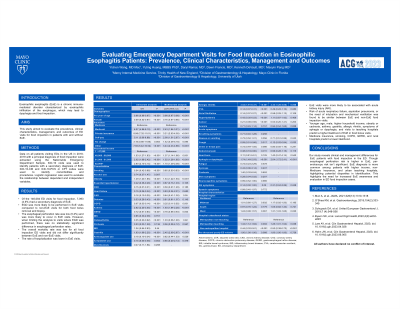Monday Poster Session
Category: Esophagus
P1839 - Evaluating Emergency Department Visits for Food Impaction in Eosinophilic Esophagitis Patients: Prevalence, Clinical Characteristics, Management, and Outcomes
Monday, October 23, 2023
10:30 AM - 4:15 PM PT
Location: Exhibit Hall

Has Audio
.jpg)
Yuting Huang, MBBS, PhD
Mayo Clinic Florida
Jacksonville, FL
Presenting Author(s)
Yichen Wang, MD, MSc1, Yuting Huang, MBBS, PhD2, Daryl Ramai, MD, MSc3, Dawn Francis, MD2, Kenneth DeVault, MD2, Maoyin Pang, MD, PhD2
1Mercy Internal Medicine Service, Trinity Health of New England, Springfield, MA; 2Mayo Clinic Florida, Jacksonville, FL; 3University of Utah, Salt Lake City, UT
Introduction: Eosinophilic esophagitis (EoE) is a chronic immune-mediated disorder characterized by eosinophilic infiltration of esophagus, potentially resulting in dysphagia and food impaction. The association between food impaction-related emergency department (ED) visits and EoE remains underexplored. This study evaluates the prevalence, clinical characteristics, management, and outcomes of ED visits for food impaction in patients with and without EoE.
Methods: We utilized the Nationwide Emergency Department Sample to extract data on all ED visits in the US in 2018-2019 with a principal diagnosis of food impaction. The validated ICD-10 code identified patients with a secondary diagnosis of EoE. Relevant comorbidities and symptoms were identified using corresponding ICD-10-CM codes and procedures with ICD-10-PCS or CPT codes. Sampling weights and strata were applied to obtain nationally representative results using the HCUP-provided method. Logistic regression evaluated relationships between dependent and independent variables.
Results: Among 146,084 ED visits for food impaction, 7,093 (4.9%) had a secondary diagnosis of EoE. EGD was more likely to be performed in EoE visits for both food bolus removal (72.4% vs. 43.2%, P < .001) and biopsy (54.9% vs. 13.4%, P < .001). No significant difference existed in esophageal perforation between groups undergoing EGD (aOR 2.89, 95% CI 0.84-9.98, P =.094). Overall mortality rate was low (0.07%) and similar (P =.773). Hospitalization rates were lower in EoE visits (6.0% vs. 10.2%, aOR 0.74, 95% CI 0.59-0.92, P =.008). Younger age, male, non-Medicare insurance, higher household income, and visits to teaching hospitals predicted higher likelihood of EoE. Patients with aphagia and dysphagia, gastritis, obesity, asthma, and allergic rhinitis were more likely to have EoE (Table).
Discussion: This study highlights distinct clinical characteristics and management approaches for EoE patients experiencing food impaction-related ED visits compared to non-EoE patients. EoE diagnosis was more prevalent among certain demographic and hospital-related factors, suggesting potential disparities in identification and diagnosis of the condition. Specific symptoms and comorbidities may inform healthcare providers of the likelihood of EoE. Increased awareness and prompt evaluation of EoE among patients presenting with food impaction in the ED are needed to facilitate better diagnostic and management strategies that ultimately enhance patient care.
Disclosures:
Yichen Wang, MD, MSc1, Yuting Huang, MBBS, PhD2, Daryl Ramai, MD, MSc3, Dawn Francis, MD2, Kenneth DeVault, MD2, Maoyin Pang, MD, PhD2. P1839 - Evaluating Emergency Department Visits for Food Impaction in Eosinophilic Esophagitis Patients: Prevalence, Clinical Characteristics, Management, and Outcomes, ACG 2023 Annual Scientific Meeting Abstracts. Vancouver, BC, Canada: American College of Gastroenterology.
1Mercy Internal Medicine Service, Trinity Health of New England, Springfield, MA; 2Mayo Clinic Florida, Jacksonville, FL; 3University of Utah, Salt Lake City, UT
Introduction: Eosinophilic esophagitis (EoE) is a chronic immune-mediated disorder characterized by eosinophilic infiltration of esophagus, potentially resulting in dysphagia and food impaction. The association between food impaction-related emergency department (ED) visits and EoE remains underexplored. This study evaluates the prevalence, clinical characteristics, management, and outcomes of ED visits for food impaction in patients with and without EoE.
Methods: We utilized the Nationwide Emergency Department Sample to extract data on all ED visits in the US in 2018-2019 with a principal diagnosis of food impaction. The validated ICD-10 code identified patients with a secondary diagnosis of EoE. Relevant comorbidities and symptoms were identified using corresponding ICD-10-CM codes and procedures with ICD-10-PCS or CPT codes. Sampling weights and strata were applied to obtain nationally representative results using the HCUP-provided method. Logistic regression evaluated relationships between dependent and independent variables.
Results: Among 146,084 ED visits for food impaction, 7,093 (4.9%) had a secondary diagnosis of EoE. EGD was more likely to be performed in EoE visits for both food bolus removal (72.4% vs. 43.2%, P < .001) and biopsy (54.9% vs. 13.4%, P < .001). No significant difference existed in esophageal perforation between groups undergoing EGD (aOR 2.89, 95% CI 0.84-9.98, P =.094). Overall mortality rate was low (0.07%) and similar (P =.773). Hospitalization rates were lower in EoE visits (6.0% vs. 10.2%, aOR 0.74, 95% CI 0.59-0.92, P =.008). Younger age, male, non-Medicare insurance, higher household income, and visits to teaching hospitals predicted higher likelihood of EoE. Patients with aphagia and dysphagia, gastritis, obesity, asthma, and allergic rhinitis were more likely to have EoE (Table).
Discussion: This study highlights distinct clinical characteristics and management approaches for EoE patients experiencing food impaction-related ED visits compared to non-EoE patients. EoE diagnosis was more prevalent among certain demographic and hospital-related factors, suggesting potential disparities in identification and diagnosis of the condition. Specific symptoms and comorbidities may inform healthcare providers of the likelihood of EoE. Increased awareness and prompt evaluation of EoE among patients presenting with food impaction in the ED are needed to facilitate better diagnostic and management strategies that ultimately enhance patient care.
Disclosures:
Yichen Wang indicated no relevant financial relationships.
Yuting Huang indicated no relevant financial relationships.
Daryl Ramai indicated no relevant financial relationships.
Dawn Francis indicated no relevant financial relationships.
Kenneth DeVault indicated no relevant financial relationships.
Maoyin Pang indicated no relevant financial relationships.
Yichen Wang, MD, MSc1, Yuting Huang, MBBS, PhD2, Daryl Ramai, MD, MSc3, Dawn Francis, MD2, Kenneth DeVault, MD2, Maoyin Pang, MD, PhD2. P1839 - Evaluating Emergency Department Visits for Food Impaction in Eosinophilic Esophagitis Patients: Prevalence, Clinical Characteristics, Management, and Outcomes, ACG 2023 Annual Scientific Meeting Abstracts. Vancouver, BC, Canada: American College of Gastroenterology.
